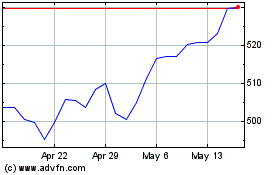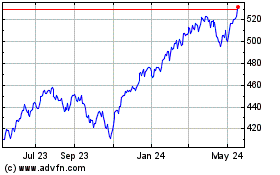Macro Indicators On Radar for S&P 500 Investors This Week
September 04 2023 - 5:01AM
Finscreener.org
The
Dow Jones Industrial Average concluded a strong week with a slight gain on
Friday, influenced by the latest U.S. jobs report. The 30-stock Dow
rose by 115.80 points, or 0.33%, finishing the day at
34,837.71.
Meanwhile, the
S&P 500 rose by
approximately 0.18% to close at 4,515.77, while the
tech-heavy Nasdaq Composite index slightly retreated, ending down 0.02% at
14,031.81.
Last week, the Dow and the Nasdaq
advanced 1.4% and 3.3%, respectively, marking their best
performances since July. The S&P 500 gained 2.5% last week
and had its strongest week since June.
The most recent U.S. nonfarm
payrolls data revealed that the unemployment rate edged up to 3.8%
in August, marking its highest point in over a year. This came as a
surprise to economists, who had forecasted it to stay at
3.5%.
Additionally, average hourly
earnings saw a year-over-year rise of 4.3%, falling short of the
4.4% increase that economists polled by Dow Jones had anticipated.
This could indicate a slowing economy and lessening inflationary
pressures.
Although AugustU+02019s payroll
numbers showed quicker-than-expected growth, adding 187,000 jobs,
there were downward revisions for the prior two months. The job
figures originally reported for June and July were collectively
reduced by 110,000.
Are interest rate hikes coming to an end in the
U.S.?
In an interview with CNBC, Steve
Wyett, chief investment strategist at BOK Financial explained last
Friday, “It would be a mistake to look at today’s employment
report, along with recent data, and say the Fed is done. Even
though trends in inflation are moving the right direction and a
broader view of the employment market would indicate wage
pressures should abate, overall economic growth is above trend and
inflation remains well above the Fed’s recently confirmed 2%
target.”
The CME Group’s FedWatch tool
indicated traders now expect a 93% chance for the Federal Reserve
to hold interest rates at current levels at its next policy meeting
later this month.
This Wednesday, the Federal
Reserve is set to release its updated Beige Book, a regular
snapshot of the U.S. economy that comes out eight times annually
and covers all 12 Fed districts. The forthcoming edition may paint
a picture of an economy holding firm, even in the face of
challenges.
Despite the FedU+02019s rate
increases and sustained high inflation, consumer expenditure—which
constitutes over two-thirds of the U.S. GDP—remains resilient.
Additionally, unemployment continues to hover near its lowest
levels in decades.
All eyes on China
Next week, attention will also be
on China as it is slated to unveil its inflation data for August.
This is particularly significant as ChinaU+02019s economy, the
second largest in the world, experienced deflation last
month.
Consumer prices declined 0.3%
year-over-year and are expected to have seen a minor uptick of 0.1%
annually in August. ChinaU+02019s economic landscape is presently
fraught with challenges, including rising debt levels, declining
exports, a collapsing property market, and elevated youth
joblessness.
Deflation typically gains ground
during economic slumps as households put off spending, expecting
prices to drop further. This, in turn, affects businesses and their
profitability, compelling them to reduce staff, which further
curtails consumer spending. The trend initiates a vicious cycle of
economic decline that poses significant challenges for government
and central bank interventions.
SPDR S&P 500 (AMEX:SPY)
Historical Stock Chart
From Oct 2024 to Nov 2024

SPDR S&P 500 (AMEX:SPY)
Historical Stock Chart
From Nov 2023 to Nov 2024
